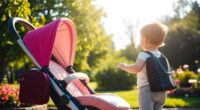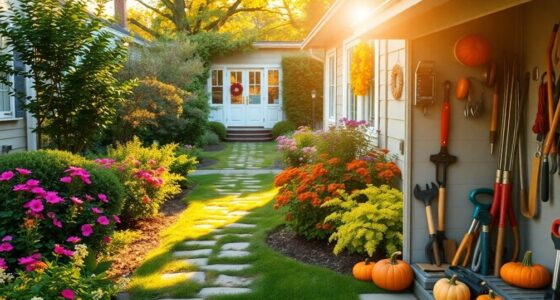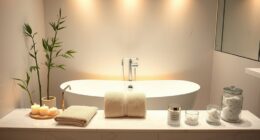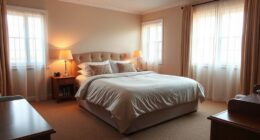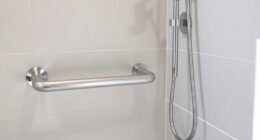To keep elderly homes safe, always have emergency numbers handy and prevent falls by ensuring proper lighting and removing hazards. Safety-proof your home by installing grab bars and handrails, especially in bathrooms. Protect against fire by installing and regularly checking smoke detectors. Avoid bathroom hazards with non-slip mats and clear clutter for easy navigation. These tips are just the beginning; there's so much more to learn about enhancing safety in your home environment.
Key Takeaways
- Install grab bars in bathrooms and near toilets to provide essential support for the elderly.
- Ensure all areas are well-lit, especially stairways and hallways, to prevent trips and falls.
- Regularly check and replace batteries in smoke detectors to ensure fire safety and functionality.
- Keep pathways clear of clutter to facilitate easy navigation and reduce the risk of accidents.
- Create and maintain an emergency contact list in large print for quick access during emergencies.
Keep Emergency Numbers Handy

When emergencies strike, having quick access to essential numbers can make all the difference. Keep a list of emergency services, like 911 and Poison Control (1-800-222-1222), easily accessible by each phone in your home.
Use large print for these contacts to guarantee they're readable in high-stress situations. Don't forget to include your healthcare provider's office number for urgent medical questions or assistance.
It's also wise to add the contact information of a trusted family member or friend who can be reached quickly if needed. Regularly review and update this list to make sure all information is current and accurate.
Prevent Falls

To prevent falls at home, it's vital to identify and address potential hazards.
With nearly one in four seniors aged 65 and older experiencing a fall each year, implementing effective home safety tips is essential for your elderly loved ones.
Here are three key actions you can take:
- Install grab bars in the bathroom and use non-slip mats to enhance safety, as this room is the most dangerous for seniors.
- Ensure proper lighting in all areas, especially staircases and hallways, to eliminate trips and falls.
- Encourage wearing non-slip footwear and moving slowly to reduce the risk of accidents on smooth surfaces.
Regularly consulting healthcare providers for falls risk assessments can also help improve strength and balance.
Safety-Proof Your Home

Preventing falls is just one part of creating a safe environment for elderly loved ones; safety-proofing the entire home is equally important.
It's vital to guarantee all hallways, stairs, and pathways are well-lit with bright lighting and night lights to help prevent trips and falls, as poor visibility contributes to many accidents. Additionally, increased smartphone usage among seniors can help them communicate quickly in case of emergencies. Engaging in regular physical activity can also improve balance and coordination, further reducing the risk of falls.
Remove scatter rugs and tape down area rugs to eliminate slipping hazards.
Installing grab bars in showers, tubs, and near toilets offers essential support, especially since bathrooms are the most dangerous rooms for falls each year.
Keep pathways clear of clutter like books or shoes to facilitate easy navigation and reduce tripping risks.
Regularly check smoke detectors, guaranteeing they're functional and replaced as needed for overall safety. Additionally, high volume from windows can contribute to hearing damage over time, making a quiet environment essential for those with hearing loss.
Protect Against Fire and Related Dangers
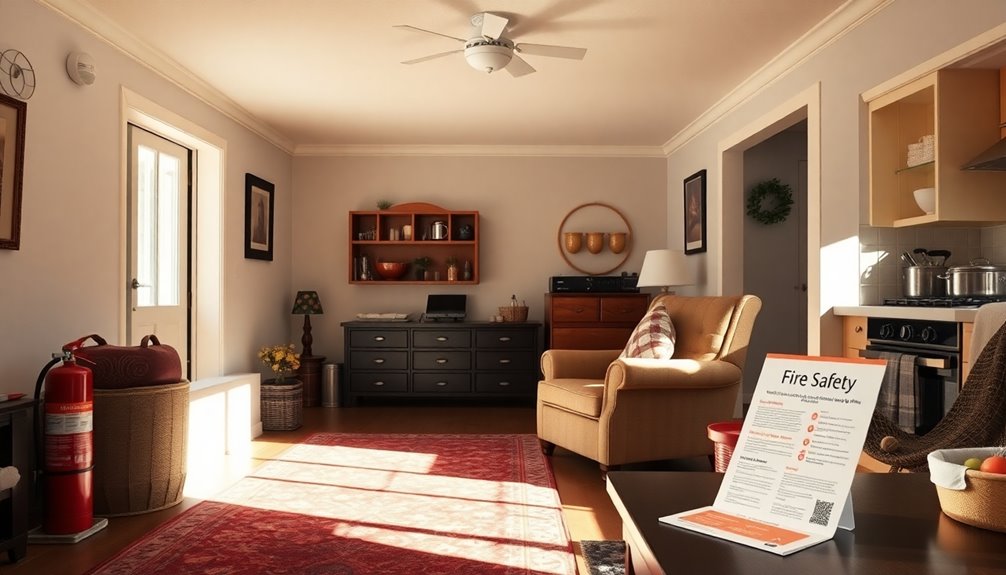
While creating a safe environment for elderly loved ones, addressing fire hazards is essential. You can greatly reduce the risk of fire with these preventive measures:
- Install smoke detectors on every level and near sleeping areas; test them monthly to verify they're functional.
- Replace damaged appliance cords promptly and keep a fire extinguisher in the kitchen for emergencies. Additionally, understanding the importance of proper planning can help avoid costly errors in emergency situations. Regular maintenance of devices like air purifiers can also prevent potential fire hazards.
- Avoid loose clothing while cooking to prevent catching fire, and familiarize yourself with at least two exit routes for quick evacuation.
Also, don't forget to install carbon monoxide detectors to guard against this deadly gas. Regularly check and replace filter replacement frequency in air purifiers to ensure they function properly and don't pose any fire risks.
In case of a fire, evacuate immediately and call 911; attempting to extinguish flames can increase the risk of injury or death.
Stay safe!
Avoid Bathroom Hazards

To keep your bathroom safe, install grab bars in the shower and near the toilet for support. Non-slip mats are a must to prevent falls on wet surfaces. These simple changes can make a big difference in avoiding bathroom hazards. Additionally, consider financial considerations for assisted living to ensure a safe and accessible environment for seniors.
Install Grab Bars
Installing grab bars in your bathroom can dramatically enhance safety and reduce the risk of falls, which are a leading cause of injuries among seniors.
Here's how you can make your bathroom safer:
- Shower and Tub: Place grab bars inside the shower or tub to help you maintain balance while bathing.
- Near the Toilet: Install a grab bar beside the toilet for easy standing up and sitting down.
- Proper Height: Position grab bars at a height of 33 to 36 inches above the floor for maximum support. Regularly checking their stability is crucial as individual responses vary based on the specific needs of seniors. Additionally, these installations are part of a larger strategy to create safer living spaces that promote independence and well-being for elderly individuals.
Make certain these bars are securely anchored and can support at least 250 pounds. Additionally, these enhancements are essential for aging in place as they create a safer environment for seniors.
Regularly check their stability to verify they remain effective, reducing the risk of falls.
Use Non-Slip Mats
Ensuring your bathroom is safe means using non-slip mats, as they can greatly lower the chances of slips and falls. Slippery surfaces in bathtubs and showers are common hazards, especially for seniors.
By installing non-slip mats, you considerably reduce the fall risk associated with these areas. Choose mats made from materials that provide excellent traction and stay securely in place to prevent any sliding while in use.
Remember to regularly inspect your non-slip mats for wear and tear, as damaged mats can lose their effectiveness, increasing the fall risk.
For added convenience, opt for mats that are easy to clean and maintain, ensuring they remain hygienic and effective over time.
Prioritizing safety in your bathroom is essential for preventing injuries.
Ensure Adequate Lighting
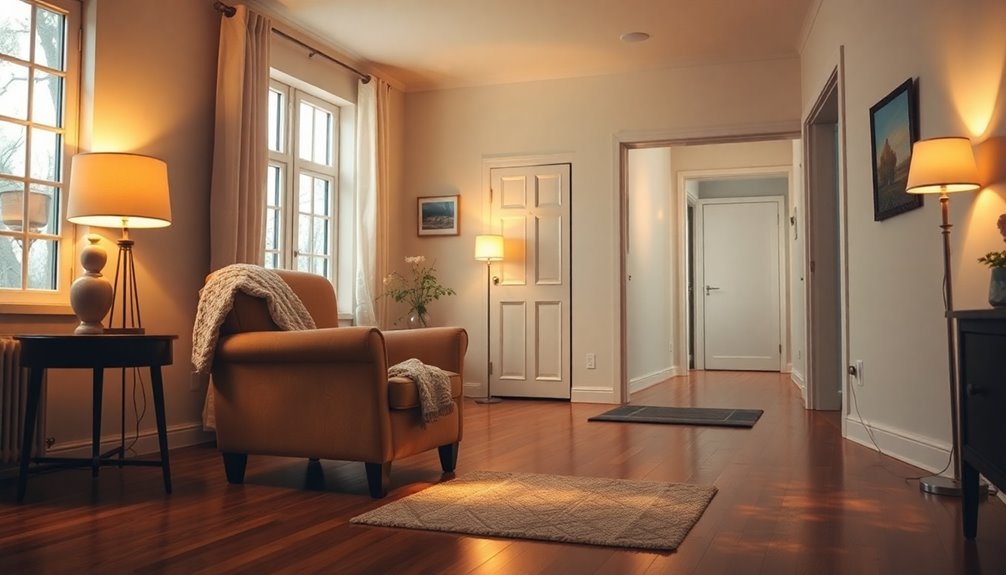
While steering through your home, good lighting isn't just a comfort—it's an essential safety measure.
Adequate lighting greatly reduces the risk of injury for your senior loved ones. To guarantee safety, consider these key actions:
- Replace burnt-out bulbs promptly to keep all areas bright, especially in hallways and bathrooms.
- Install additional fixtures in high-traffic areas to enhance visibility, particularly on staircases. Furthermore, studies show that coffee consumption can improve cognitive function, which may help seniors navigate their environment more safely.
- Use night lights in bedrooms, bathrooms, and hallways to provide illumination during nighttime hours. Furthermore, ensuring proper water efficiency features can also contribute to a safer home environment by reducing the risk of slips in wet areas.
Moreover, ensuring proper maintenance of heat pumps can prevent accidents related to temperature fluctuations and enhance overall home safety.
Clear Clutter and Ensure Easy Navigation
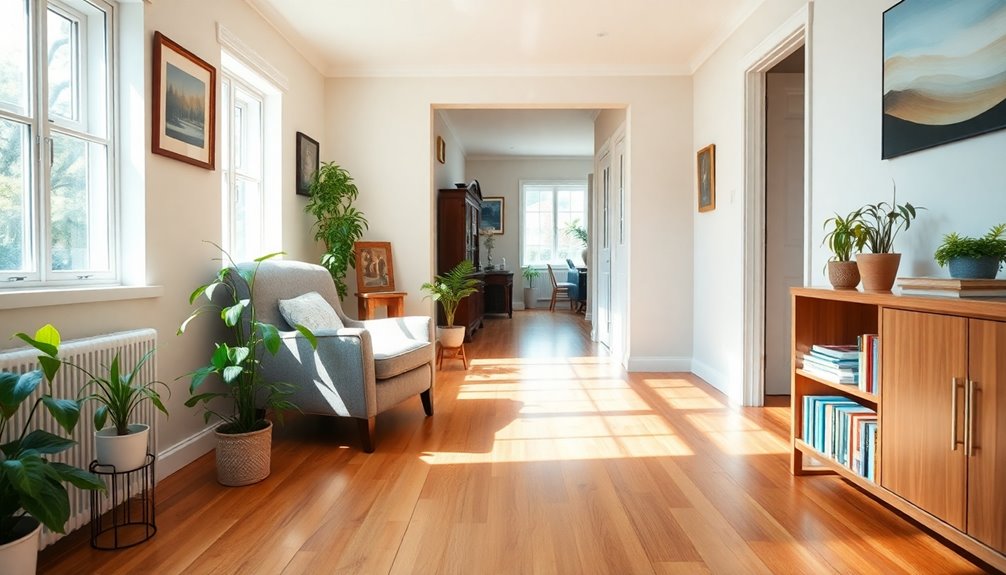
Clutter can quickly become a hidden danger in your home, so it's crucial to keep pathways clear and organized.
Start by removing hazards like boxes, newspapers, and cords from walkways to minimize the risk of falls. Store frequently used items within easy reach to prevent stretching or climbing. In addition, keeping pathways clear can also help reduce stress for elderly individuals navigating their homes. Regular cleaning promotes better air quality, which contributes to a healthier environment for seniors.
Guarantee pathways to light switches are unobstructed, so you can access lighting without difficulty. Consider using night lights in bedrooms, bathrooms, and hallways to enhance visibility at night, reducing the chances of trips and falls.
Finally, secure loose rugs with tape or tacks to prevent tripping hazards. Additionally, consider employing a robot vacuum to maintain clean floors, ensuring that debris does not accumulate and create further hazards.
Install Grab Bars and Handrails
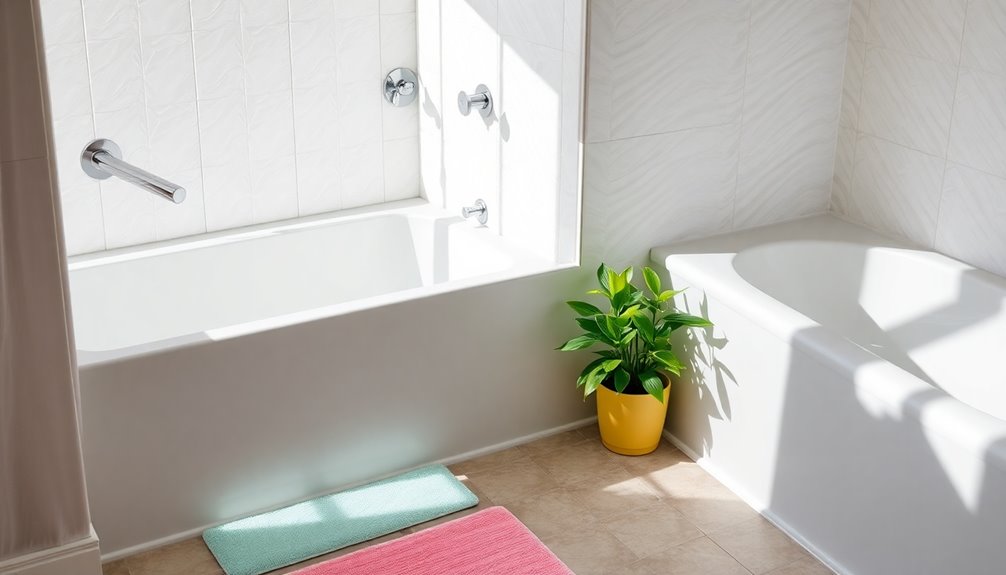
To enhance safety in your home, installing grab bars and handrails is essential for preventing falls, especially in areas where seniors are most vulnerable.
These installations can greatly reduce fall risks, providing essential support.
Here are three key places to evaluate:
- Grab bars in showers and next to toilets to aid in safe changes.
- Handrails on both sides of stairways to offer a stable grip while traversing steps.
- Non-slip treads on bare-wood steps to improve traction and minimize slips.
Regularly Check and Install Smoke Detectors

Guaranteeing safety in elderly homes goes beyond installing grab bars and handrails; regular checks of smoke detectors are equally important.
Test your smoke detectors monthly to verify they're functioning properly since faulty detectors are a leading cause of fire-related fatalities. It's important to make certain you replace the batteries at least once a year, and consider using lithium batteries for longer life.
Install smoke detectors on every level and near sleeping areas to provide early warnings against smoke and carbon monoxide. Remember to replace smoke detectors every 10 years, as their sensors degrade over time.
For added safety, consider interconnected smoke alarms, which alert all alarms when one detects smoke, offering peace of mind for seniors.
Create an Emergency Plan and Kit

Creating an emergency plan and kit is vital for ensuring everyone's safety during unexpected situations.
Start by listing important contacts, including healthcare providers, and gather essential first aid supplies.
Don't forget to establish a clear communication plan so everyone knows how to stay in touch when it matters most.
Emergency Contact List
How prepared are you for an emergency? Having an up-to-date emergency contact list is essential for anyone wanting to live independently in their home environment.
Make sure it's easily accessible and in large print for better readability. Include important numbers like:
- 911
- Poison Control (1-800-222-1222)
- A family member's contact
Don't forget to add your healthcare provider's office number for immediate medical assistance.
Regularly review and update this list to reflect any changes.
Additionally, consider creating an emergency kit stocked with basics like water, non-perishable food, and a flashlight.
Being prepared can make a significant difference in emergencies, keeping you safe and secure in your home.
First Aid Supplies
A well-stocked first aid kit is crucial for addressing unexpected injuries and emergencies in your home. For older adults, having an emergency plan that includes a thorough first aid kit can make all the difference. Here's a quick checklist of essential first aid supplies:
| Supply | Purpose | Quantity |
|---|---|---|
| Adhesive Bandages | Cover minor cuts and scrapes | 10 |
| Sterile Gauze | Stop bleeding | 5 |
| Antiseptic Wipes | Clean wounds | 20 |
| Digital Thermometer | Check for fever | 1 |
Regularly check your first aid supplies to verify they're up-to-date. Also, include your emergency plan and medical information in your kit to help responders when needed. Be prepared!
Communication Plan
Having a well-stocked first aid kit is just one part of guaranteeing safety in your home; a solid communication plan is equally important.
If you or a loved one is living alone, having a clear emergency plan can make all the difference.
- Emergency Numbers: Keep a list of important contacts, including 911 and Poison Control (1-800-222-1222), easily accessible by each phone.
- Emergency Contact: Designate a family member or friend as your emergency contact and include their details in your plan.
- Emergency Kit: Create a kit filled with water, non-perishable food, first aid items, and medications, assuring it's within easy reach.
Remember to regularly review and practice your emergency plan to guarantee everyone knows what to do when needed.
Frequently Asked Questions
How Can Elderly Prevent Home Accidents?
To prevent home accidents, you should keep your living space well-lit and clutter-free, especially in hallways and stairs.
Install grab bars in the bathroom for extra support, and use non-slip mats in the tub.
Regularly check smoke detectors to verify they're working, and maintain a comfortable home temperature to avoid cold-related issues.
Finally, consider using footwear that provides good traction to minimize the risk of slipping and falling.
What Are the Safety Tips for Elderly People at Home?
To keep yourself safe at home, start by installing grab bars in bathrooms and along stairs for added support.
Make sure all areas are well-lit, especially hallways and staircases, to avoid trips.
Keep pathways clear of clutter, and use non-slip mats in the bathroom.
Regularly check smoke detectors and avoid loose clothing while cooking.
These simple steps can substantially reduce your risk of accidents and help you stay independent longer.
What Are the 7 Physical Needs of the Elderly?
When considering the physical needs of the elderly, you should focus on several key areas.
First, guarantee they receive proper nutrition to support their health.
Next, encourage regular physical activity to maintain strength and balance.
Access to healthcare services is essential for managing chronic conditions.
Don't forget hydration; aim for at least 8 cups of fluids daily.
Finally, promote social interaction to boost mental well-being and reduce feelings of loneliness.
What Are the 8 Needs of the Elderly?
When considering the needs of the elderly, you should focus on eight key areas: health care, social interaction, nutrition, safety, transportation, mental stimulation, personal care, and emotional support.
Regular health check-ups are essential, while social connections help combat isolation. A balanced diet and a safe living environment keep them healthy.
Transportation access allows independence, and mental engagement is important for cognitive health.
Finally, emotional support guarantees they feel valued and cared for.
Conclusion
In conclusion, maintaining a safe environment for the elderly is essential to preventing accidents. Did you know that nearly one in four older adults experience a fall each year? By keeping emergency numbers handy, safety-proofing your home, and installing grab bars, you can greatly reduce these risks. Remember, a little effort goes a long way in ensuring the well-being of your loved ones. Stay proactive, and create a secure haven where they can thrive and enjoy their golden years.

